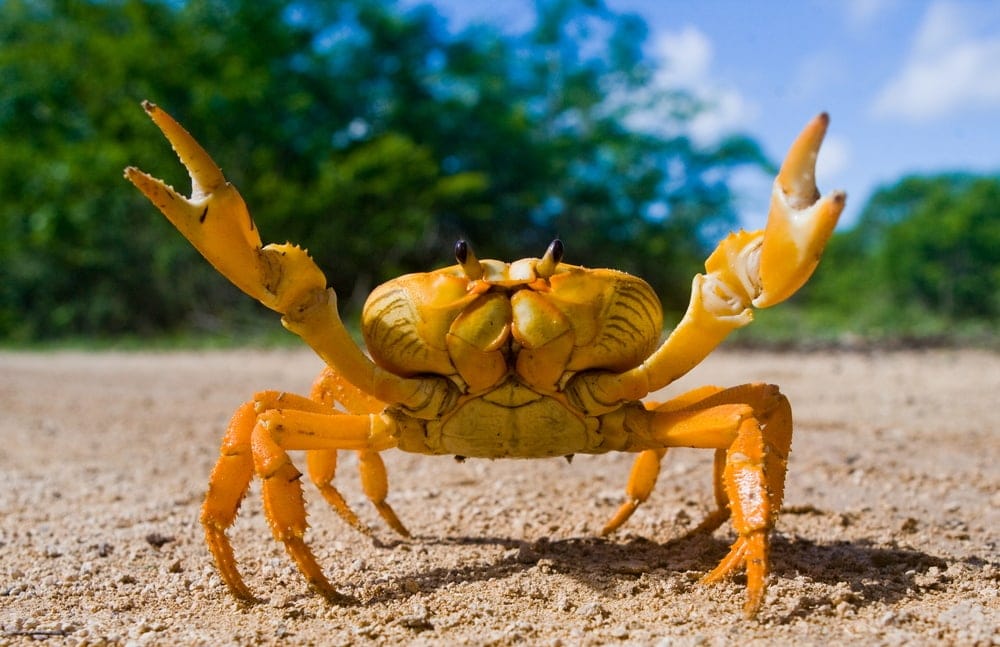
Crabs are one of the oldest living species, its ancestors dating back over 400 million years ago. Crabs have even been around about 200 million years before the dinosaurs! There are over 4,500 types of crabs across the globe, and over 850 different species.
If you’d like to know what it is about crabs that have enabled them to live for so long, you’ve come to the right place.
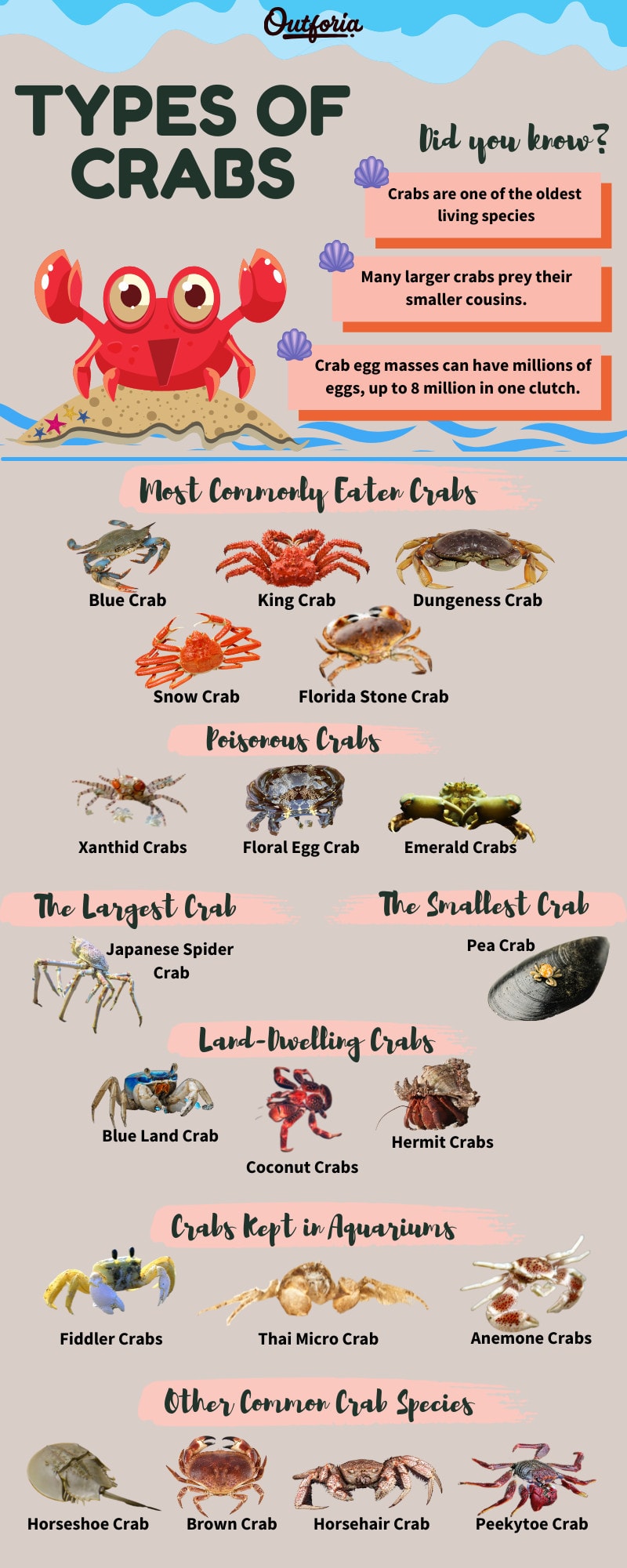
Share Image On Your Site
<a href="https://outforia.com/types-of-crabs/"><img style="width:100%;" src="https://outforia.com/wp-content/uploads/2021/12/Types-of-Crabs-Infographics-1.jpg"></a><br>Types of Crabs Infographic by <a href="https://outforia.com">Outforia</a>Classification & Species
All crabs are classified as decapods: a crustacean with five pairs of legs on the upper half of their body. At least one of these appendages will be modified into a pair of pincers or claws. They have stalked eyes, and their head and thorax fused together, covered by a carapace.
Taxonomy of Crabs
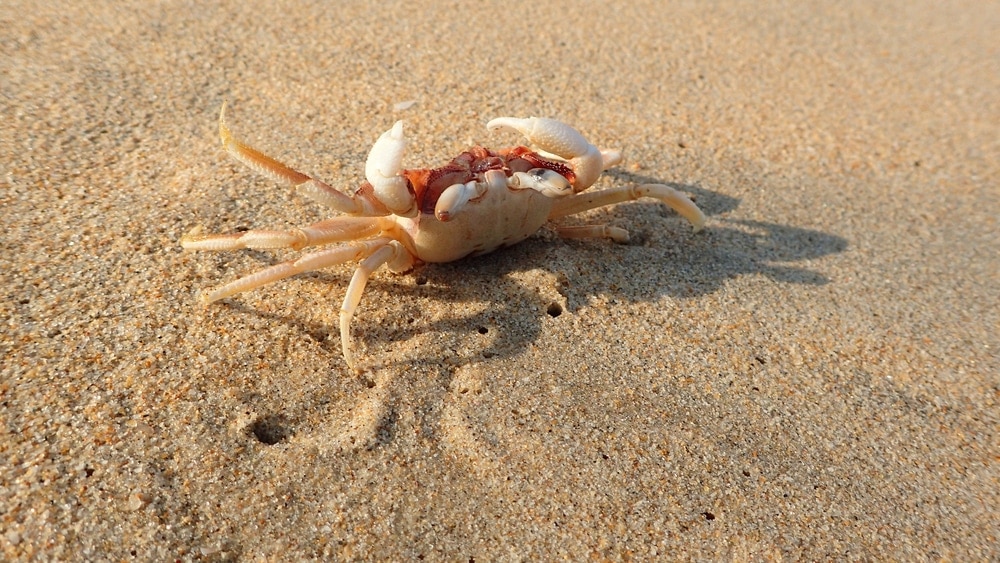
Taxonomy is a part of science that helps us to classify all living things on earth. All living creatures will be divided into groups based on what they have in common. There are different levels of classification, and the further down we go, the more specific their taxonomic names will be.
Here’s the general taxonomic structure of crabs.
Kingdom: Animalia — a group of all multicellular animals
Phylum: Arthropoda — invertebrates (segmented body, external skeleton, & jointed limbs) that include insects, spiders, and crustaceans.
Subphylum: Crustacea — aquatic arthropods with four or more pairs of limbs with one or more modified into pincers.
Class: Malacostraca — crustaceans that have compound eyes, usually on stalks.
Order: Decapoda — the head and thorax are fused and covered by a carapace.
Suborder: Pleocyemata — fertilised eggs incubated by the female and remain on the swimming legs (pleopods) until hatching.
Infraorder: Brachyura — short abdomens that fold toward the underside of the animal’s body.
In addition to taxonomic status, crabs have been further broken down into four main categories for classification.
Dromiacea

Crabs in this group are classified by their last pair of legs. The thoracic legs are modified, closer to their back, with a pair of hinged pincers. These modified pincers are used to eat, display for potential mates, and to decorate their carapace with shells.
This group of crabs contains 300 extinct and 240 living kinds of crabs. The oldest fossil from this group of crabs dates back to the Jurassic period, about 200 million years ago.
Raninoida
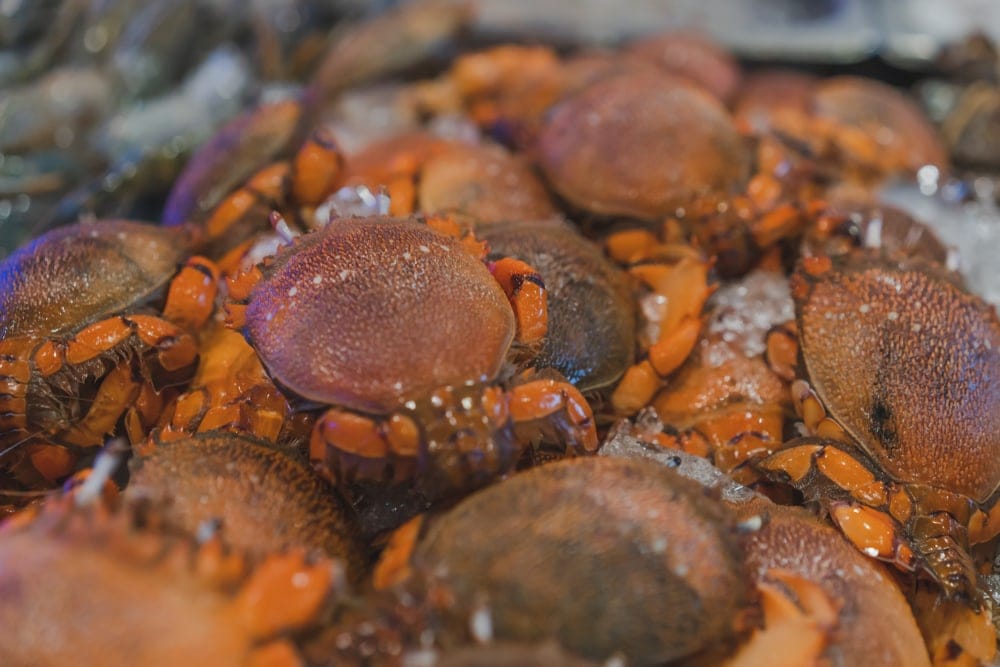
This crab superfamily is unique from other crabs because of the appearance of its abdomen. It includes 182 species, 24 genera, and 4 families.
This group of crabs has been around since the cretaceous period, about 145-66 million years ago.
To move around, these crabs rely on drag-powered swimming, a kind of motion where the crab paddles in a horizontal, circular motion. They push water behind them similar to how you’d row a boat.
Cyclodorippoida
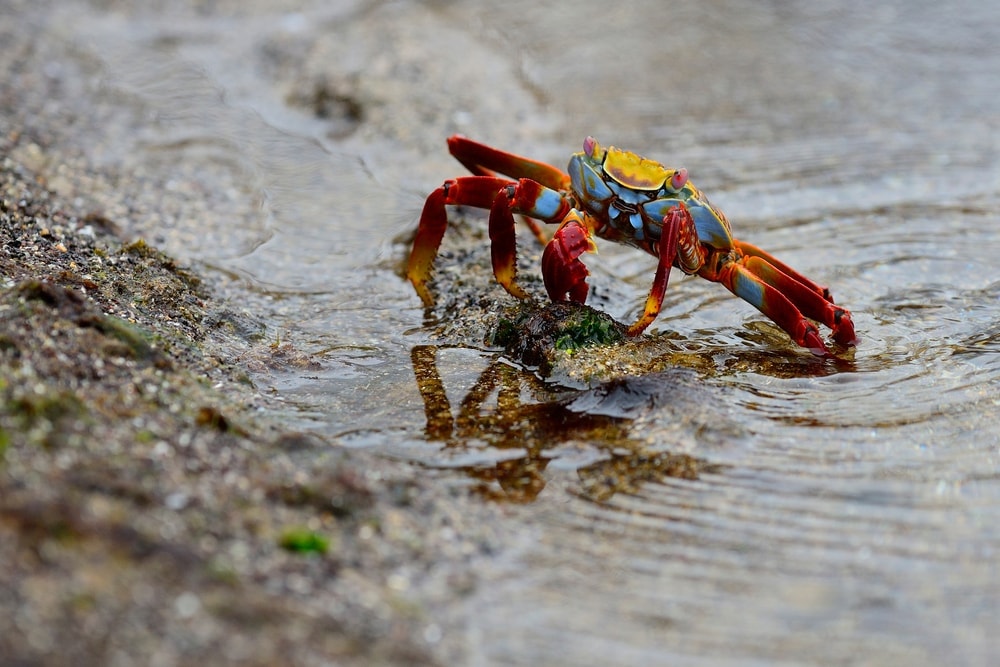
This group of crabs also contains a single superfamily called Cyclodorippoidea. Within this superfamily are three families: Cyclodorippidae, Cymonomidae, and Phyl lotymolinidae.
Eubrachyura
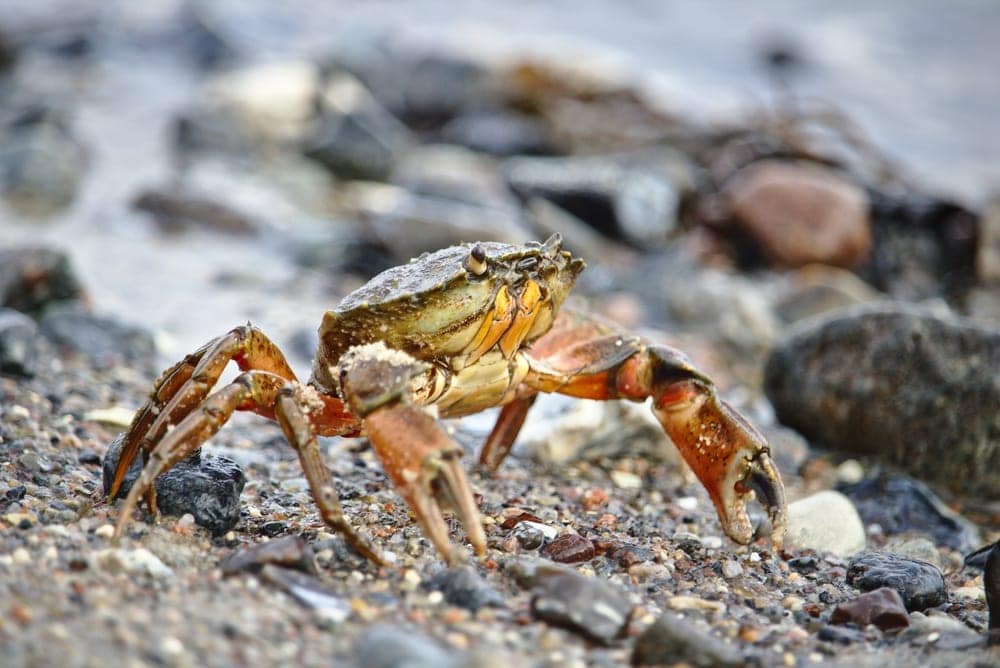
Crabs in this group are more physically and mentally advanced than other crabs, and they are split into two groups: Heterotremata and Thoracotremata. These two groups are distinguished based on the positions of the genital openings.
In Heterotremata, the genital openings on the males are found on their legs, while they are found on the sternum in females.
In Thoracotremata, the openings for both the male and female are on the sternum.
Crabs from this group date back to the Bathonian period, about 168-166 million years ago.
Mating

Crabs mate directly after they’ve molted while at higher risk of predation. When a crab molts, its hard outer shell comes off and is replaced by a soft shell that has newly developed underneath.
They choose to mate after molting because their hard exoskeleton makes the mating process difficult.
Males find a female that is preparing to molt, and will cradle her before she molts. After mating, the male will stay with the female until she has regrown her exoskeleton to protect her.
After mating, the female holds its eggs underneath its abdomen. This often appears as an orange, spongy material under their carapace.
Life Cycle
Crabs all have the same basic life cycle. Specifics may vary between species, but they are all born and develop in the same way.
The basic life cycle of a crab is below:
- Eggs
- Zoea
- Megalopa
- Juvenile Crab
- Adult Crab
Life Cycle of a Blue Crab
To go into more detail, we will be following the life cycle of a blue crab.
The Zoeal Stage
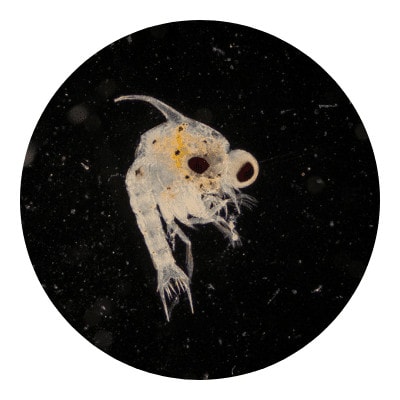
When blue crabs first hatch from their eggs, they don’t look much like crabs. They are microscopic larvae, or zoea.
Young crabs will be free-floating throughout the water column in areas where the salinity is high. They eat microscopic pieces of algae, and other, smaller larvae.
The blue crab will go through seven stages of larval development. In total, the larva will spend 31-49 days going through these stages of larval development before becoming an adult crab. In each stage, the larva will look quite similar, but they will become slightly larger.
Like their adult forms, crab zoea have exoskeletons and need to molt to allow their body to go through changes.
The Megalopal Stage
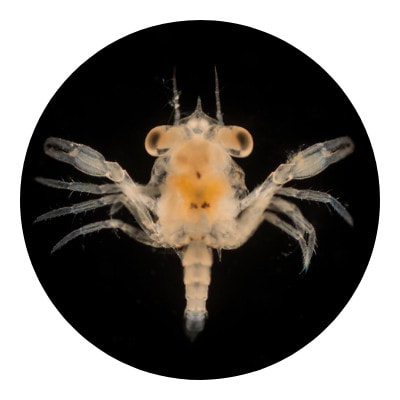
After the larval stage is over, the young crab will enter the megalopal stage where the larva begins to take on a more crab-like form. This stage can last anywhere from 6-20 days.
It consists of the young crab’s body becoming wider with legs stretching out from the sides. They still retain their long abdomen from their zoea stage, however, and it stretches out behind their bodies.
Unlike the zoea who is free-floating, the megalopas prefer areas with lower salinity and plenty of places to hide. They will use the tides coming in and out to travel to estuaries that meet these requirements, and where it is easier for them to find food.
The Adult Form

Once in the estuary, the crab will molt into a “true” crab form, although it is much smaller than its adult form, about 2 mm (0.2 cm) in length.
As an adult, a blue crab remains in the estuary. They will molt more frequently during the warmer months, and will slow down when it’s cold. Eventually, the crab will reach sexual maturity, at which point they will go through a “terminal” molt, the last molt of their life cycle. After they have molted for the last time, they will no longer grow.
This terminal molt is when crabs mate. After mating, the male will remain in the estuary for his full life while the female will move to an area of higher salinity to prepare the eggs.
Eggs

Female blue crabs are particular about where they lay their eggs, and they can hold sperm for up to a full year. Doing this allows them to take the time they need to find the perfect spot before extruding their eggs. It also means that they can mate during the colder months and wait until the warmer season to extrude their eggs.
Fertilization takes place as the eggs leave the crab’s body and make their way to the “apron” underneath the crab’s body. The “apron” refers to the abdomen which is curled-under to allow the deposit of eggs. There are small appendages there which the eggs attach to.
Egg masses can have millions of eggs, up to 8 million in one clutch. In the earliest stages, the egg mass will appear orange because of the large amounts of yolks in the eggs. As the eggs develop and the larvae consume the yolks, the egg mass will turn into a brownish color. The eggs will hatch in 1-2 weeks.
From there, the life cycle of the crab begins again, although only about 0.0001% of the total eggs will survive to become adults.
You may also like: Explore the Butterfly’s Incredible Life Cycle and its 29 Different Types (with pictures and more)
Diet
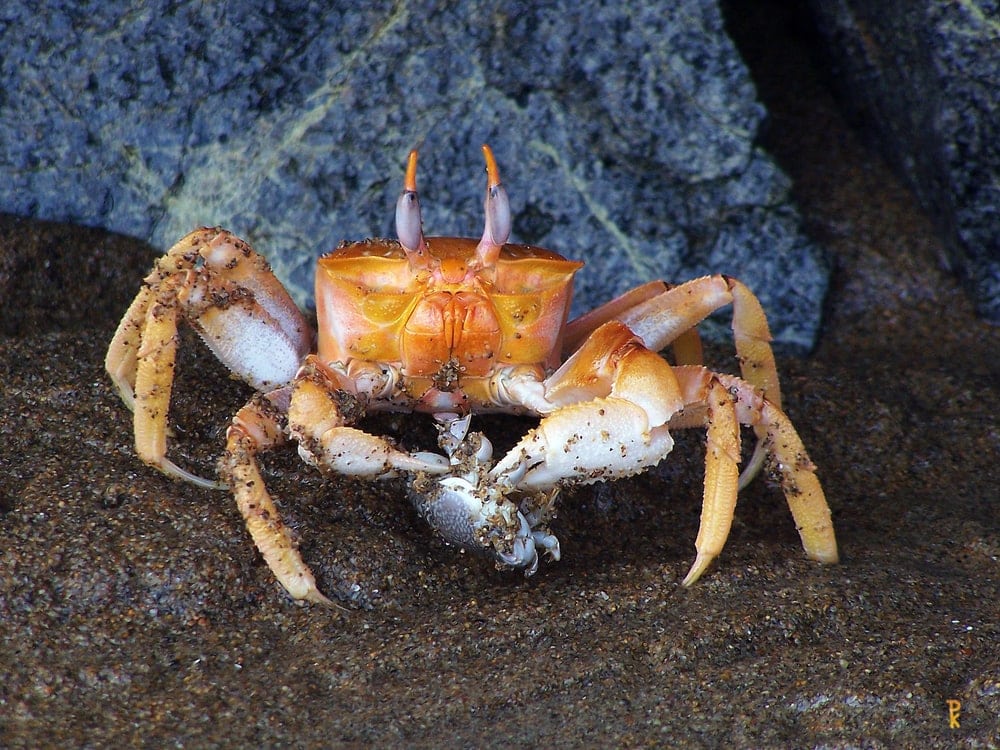
The diets of crabs differ between each kind of crab and where it lives.
In general, most crabs are omnivorous, meaning that they eat both plant and animal material. Most are also scavengers, so they will usually eat anything and everything they can get their claws on. Here are some foods that make up the diets of most crabs:
- Detritus like decaying plant matter or dead fish
- Snails
- Algae
- Live plants
- Barnacles
- Shrimp
- Worms
- Other crabs
Natural Predators

While crabs are protected with a hard shell surrounding their body, they are still at risk of predation. Some bigger, more aggressive types of fish like bass, halibut, cod, and sharks will all easily make a meal of a tasty crab.
Besides fish, invertebrates, like octopi, also eat crab. They have hard, sharp beaks to tear open crab shells. When an octopus bites a crab, the bite is fatal, initially paralysing it so that it can no longer fight back.
Sea turtles are also a fearsome predator because they have large, powerful jaws that easily let them crush through the shells of crabs.
Not only do crabs have to worry about ocean animals feasting on them, but they also worry about mammals such as sea otters and seals who can eat large amounts of crab in a single day.
Worst yet, crabs must worry about predation from other crabs! Many larger crabs will go after their smaller cousins. Still, many crabs of the same size and species, like the blue crab, are cannibalistic and will go after each other.
Young, larval crabs are especially vulnerable to predation, particularly by smaller fish, rays, and eels.
Habitat, Migration, & Range
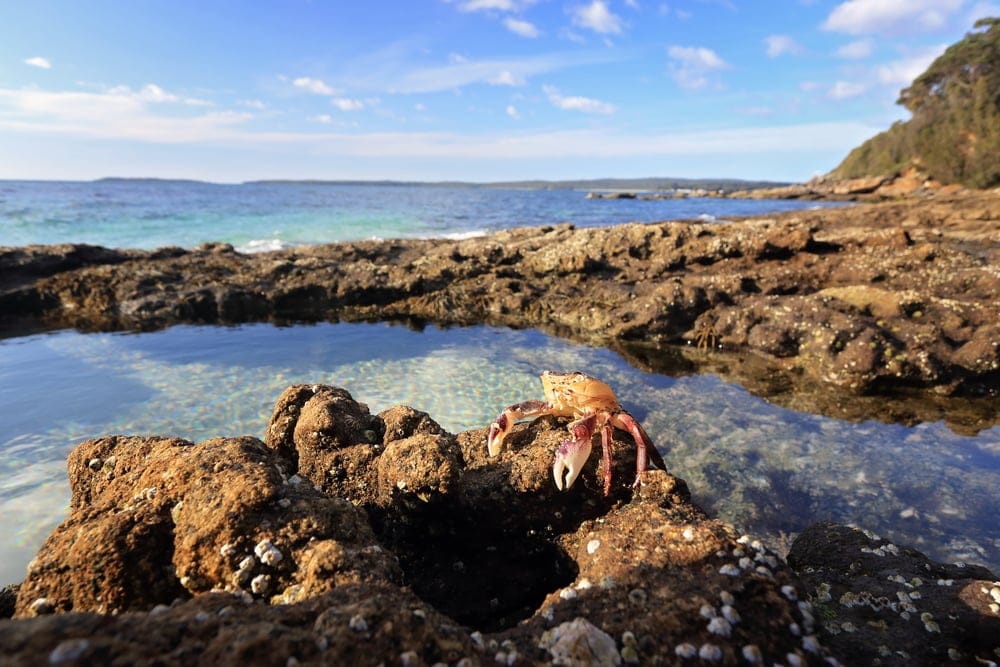
Different kinds of crabs can be found all over the world. They can be found in freshwater, saltwater, and brackish water regions, with some species inhabiting cold waters, and others warm. Some crabs even live on land.
Blue Crab Habitation
Most of the migration studies of crabs have been conducted on blue crabs. They are found in northern New England down through the Mid-Atlantic and Southeast coasts of the United States, down through Nova Scotia and Argentina.
Male blue crabs prefer waters with less salinity, like estuaries and tributaries. Females like areas with higher salinity and are more commonly found in the ocean or closer to it.
Within these areas of the ocean, blue crabs like to hide in underwater grasses and oyster reefs. They tend to prefer warmer, shallow waters. When the temperatures drop too far for comfort, the crabs will burrow into the muddy sediment of the estuary where they live.
Crabs generally hibernate rather than migrating during periods of changing weather, but they will migrate for other reasons, usually related to mating and spawning. As we covered in the above sections, female blue crabs will migrate to saltier waters when she is ready to lay her eggs.
Red Crab Migration
Another example is the red crab that lives in the forests of Christmas Island. When they are ready to breed, they will migrate from the forests and make their way to the ocean. During this time, residents will see thousands of crabs moving across roads, streams, and beaches.
You may also like: Learn the 10 Types of Habitats and the Species That Lives in It: Complete with Images, Fun Facts, Descriptions, and More!
Impact of Climate Change

The effects of climate change are affecting every living species on the planet, and crabs are no exception. George Somero, the director and professor of Stanford’s Hopkins Marine Station says that the warming of ocean temperatures has drastically impacted the populations of crabs in the Pacific Ocean.
Crab Survey
A survey was conducted in the 1930s, where students surveyed and identified every marine invertebrate in a 95-square-yard (79-square-meters) area of the marine lab in Pacific Grove, California.
In 1993, this study was redone, and researchers found that there was a drastic reduction in northern species from just 60 years earlier. Alternatively, they found that 8 out of 9 of the southern species had increased significantly in number.
Thermal Tolerance
So, as climate change continues to impact the warming of ocean waters, we can be certain that already northern-living crabs will be moving further north in search of colder waters.
When species that are used to colder temperatures are made to live in warmer waters, they will reach their “thermal tolerance”. Thermal stress will push the body over the edge, and the animal may begin to experience heart and nervous system problems which could potentially be fatal.
If the ocean temperatures continue to rise at their current rates, the earth could increase another 6 degrees Fahrenheit over the next 50 years, further putting northern crab species at higher risk.
Intertidal vs Subtidal
Somero and his researchers conducted experiments testing heat tolerance levels between intertidal and subtidal habitats. They found that crabs living in intertidal regions are far more susceptible to the dangers of global warming than those living in subtidal regions.
Because intertidal-living crabs living on the Pacific coast are already living dangerously close to their thermal limits, they may not survive if ocean waters increase.
You may also like: Have a quick run-through of the 24 Types of Disasters That You Need to Know!
Cultural Symbolism of Crabs

Crabs are often seen as holding symbolism and meaning in various cultures, particularly native ones. They are seen as a symbol of renewal or regeneration of life.
They are linked to the moon and are associated with the astrological sign, “cancer.” Their association with the moon comes from the tribal belief that crabs never die, instead burying themselves to regrow their shells, similar to the “shell” of the new moon.
Commercial Fishing

Crabs are a favorite meal, enjoyed by many people, probably including you! Traps and pots are the most common methods of catching crabs, both commercially and recreationally.
Fishing vessels will be anywhere between 25-280 feet (8-85 meters) long. They drop the pots or traps into the water which are connected to a floating buoy.
Traps can be used in very shallow waters up to depths of 1,000 feet (305 meters). Traps are usually made of wire squares laid out in a grid pattern. Bait is laid inside the traps, luring the crabs inside. After about a day or so, the fishermen will return and lift the trap with a hydraulic block.
You may also like: Check out These 19 Unique Types of Eels and Learn Everything About Them: Complete with Images, Descriptions, and More!
Types of Crabs
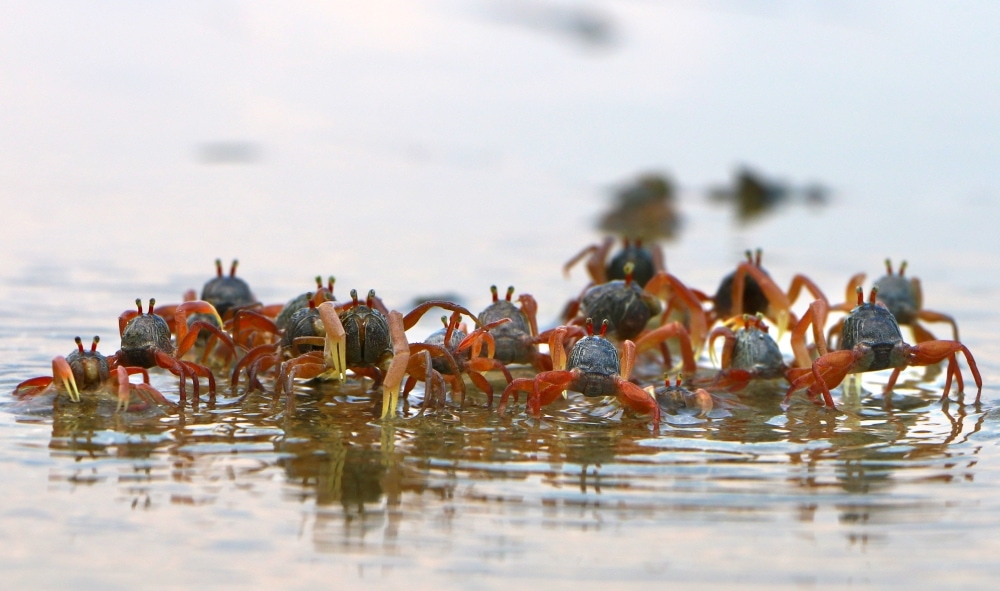
Most Commonly Eaten Crabs
It’s debatable which crabs are the tastiest to eat, but most restaurants seem to agree on the top five most flavorful crabs. It also makes sense that, with these crabs being the most popular to eat, they are also the most common and abundant species of crab across the globe.
1. Blue Crab
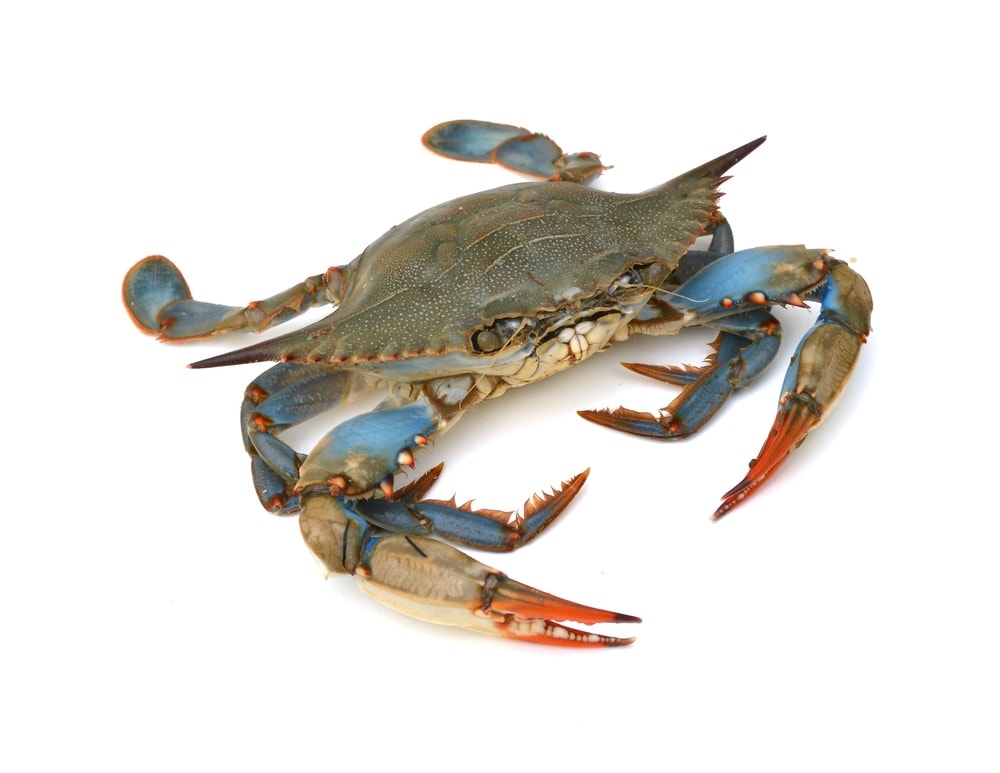
Blue Crabs are named the “beautiful swimmer”, or Calinectes sapidus in Latin. They can swim through the water column with the use of their “fins”, which act like a paddle to travel. These “fins” are really a pair of modified, flat back legs.
They not only taste great, but they are beautiful to watch in the wild. Their shell is a faint turquoise color with their legs a deep blue. Their name comes from the color that their bodies take on while they’re still alive, however, because their shells turn red once they’ve been cooked.
Being the most common crab species on the east coast of the United States, it’s no wonder that they are one of the most popular crabs to eat. They are found in coastal waters up and down the Atlantic Coast as well as the Gulf of Mexico. They can also be found in parts of Argentina.
2. Dungeness Crab

The habitation range for the Dungeness Crab is more varied than the blue crab. They live in pacific coastal waters all the way from Alaska down to Baja, Mexico. They are named after the first town that began harvesting them for food, Dungeness in Washington State.
Although they inhabit and are harvested all along this coast, 70% of their total catch is harvested between California, Oregon, and Washington.
To be harvested, these crabs must be at least 6.25 inches (1.60 meters) in length and must be male, although they can grow up to 10 inches (0.3 meters). Their shells range in color from dark brown to purple.
Although these crabs are a favorite among restaurant goers, they’re not easy to get to the table. They are excellent at avoiding being caught, masters at hiding and avoiding traps.
3. Snow Crab
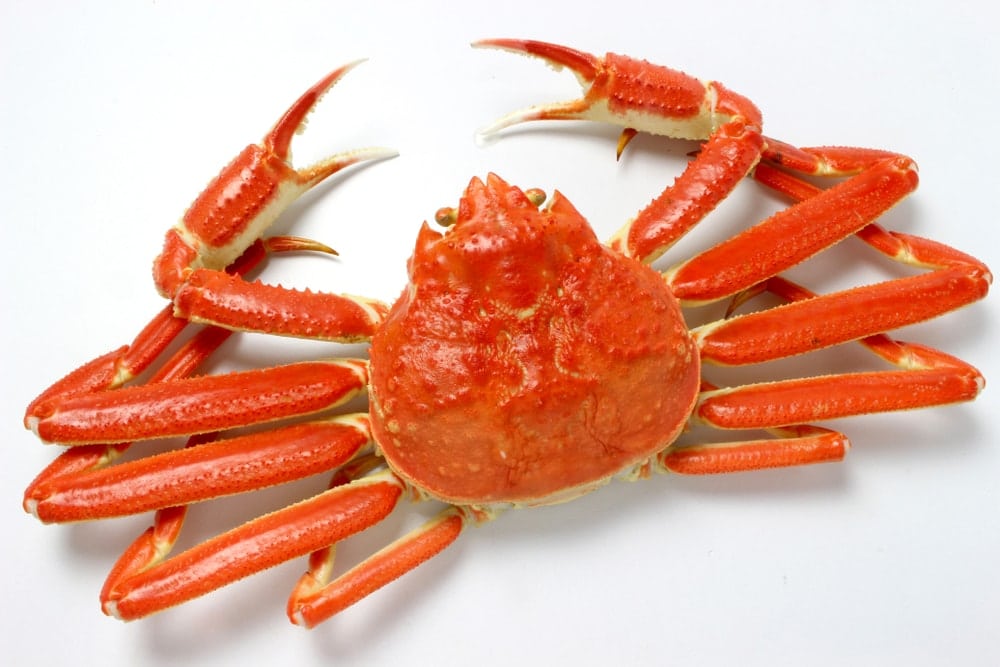
The snow crab goes by many names, its Latin name, Cancer quanbumi, being the most accurate.
One of their most common names, the rock crab, comes from where they love to live: crevices of rocks deep in the ocean. They are found in waters along the east coast of the United States.
They are also sometimes called the spider crab because of their long, spindly legs that resemble the body of a spider. Likewise, the length of its legs also leads to it being called the “queen crab”. Their legs are quite long, but shorter than that of the king crab.
Snow crabs are one of the most popular crabs to cook with and are often expensive. This is because they are only harvested in three locations around the world: the coasts of Alaska, Japan, and Canada and Maine.
4. King Crab

King crabs are appropriately named because of their spectacularly large sizes. The king crab, or Paralithodes camtschaticus, can grow up to 10 feet (3.05 meters) in length and weigh up to 25 pounds (11 kilograms).
To put that into perspective, the legs alone can grow to be five feet in length. In fact, their legs make up the bulk of their body size, their dark red carapaces only reaching about 11 inches (0.3 meters) in length.
To make their bodies more interesting, the abdomens of king crabs are so distinctive that they’re often referred to as the animal’s “tail”. The “tail” is shaped like a fan and is positioned at the rear of the shell.
Because their legs are so long, each pair has its own set of duties. A king crab has five sets of legs in all, with the center three the only ones used for walking. The front two claws contain the pinchers, with the right pincher usually being the largest. The back two legs are small, tucked underneath the carapace, aid in sperm transfer and the cleaning of embryos.
Although the crabs are so large, only about a quarter of its body is edible, so unfortunately much goes to waste. Usually, if you’re eating king crab, you’ll be eating the legs and claws which contain delicate meat. The meat is attractive both in taste and sight, the insides a pure white surrounded by a deep red on the outside.
5. Florida Stone Crab
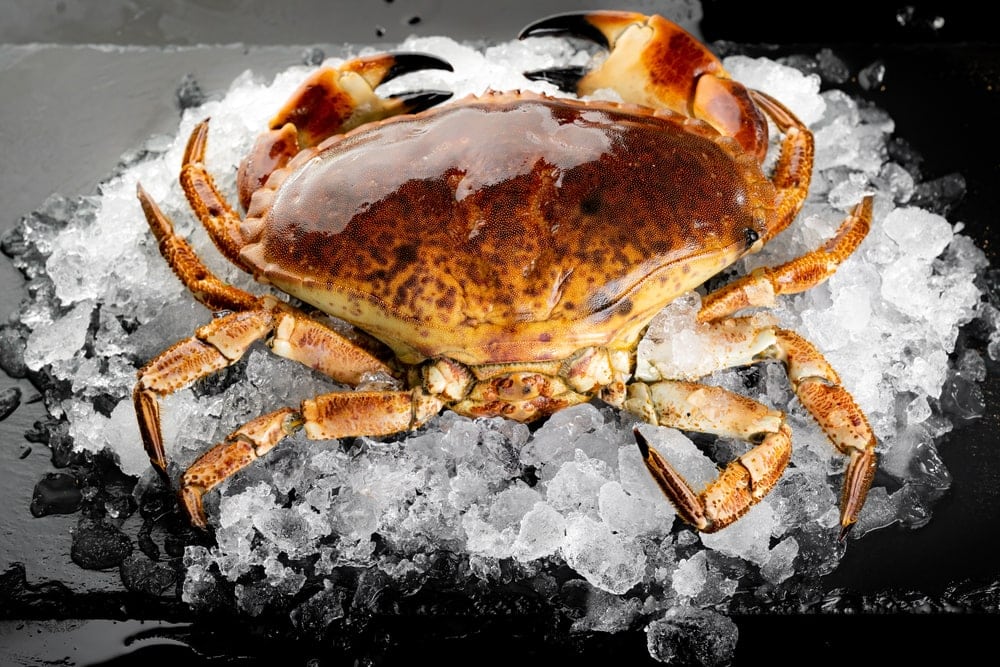
Although these crabs go by the name, “Florida” stone crab, they can be found along the western North Atlantic Ocean as far as Connecticut down to Belize. They are most commonly found off the Gulf of Mexico, the Bahamas, and in salt marshes in Georgia and South Carolina.
Stone crabs have an advantage over predators because they can grow missing limbs back. If a predator, such as a grouper, tries to eat them, they can simply leave their limb behind. Interestingly, not only will their limbs grow back, but they will come back stronger than before.
People who have eaten stone crabs say it tastes like a mixture between lobster and shrimp, making it a favorite at restaurants.
Poisonous Crabs
Although crab is a staple in the diets of people all over the world, not all crabs are safe to eat. Believe it or not, there are some crabs that are toxic.
6. Xanthid Crabs (Mosaic Crab, Toxic Reef Crab, & Shawl Crab)
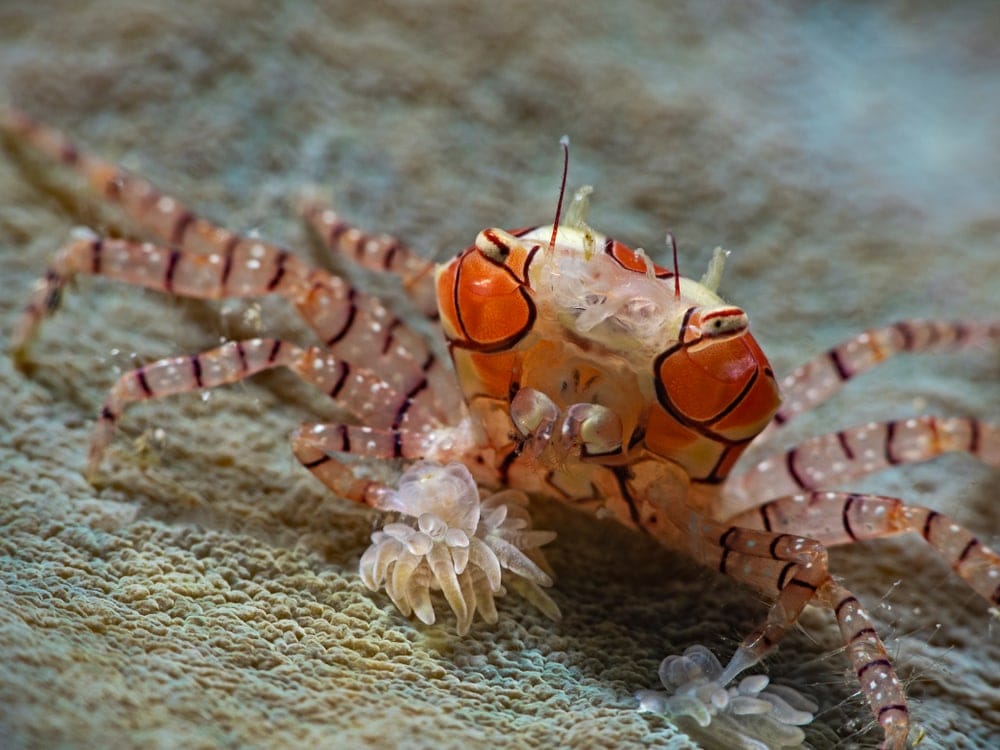
Most toxic crabs are included in the Xanthidae family which includes a group of crabs with black-tipped claws. Not all crabs of this family are toxic, and the crabs don’t produce the toxins themselves. Even some crabs in the same species are not always toxic, so this leads scientists to believe that the toxins come from the crab’s diet or from symbiotic bacteria.
Because crabs do not have spines and cannot bite, they have no way of transferring poison through contact. Therefore, you can only become poisoned by consuming them.
Xanthid crabs will hold toxins in their muscles and egg masses and can hold saxitoxin and tetrodotoxin, two of the most deadly substances found in the natural world. These substances are so toxic, in fact, that it only takes half a milligram to kill a grown adult human.
Even cooking these crabs does not kill the toxins because they are heat stable, remaining in the crab’s tissues after being cooked.
Fortunately for most of the world, these crabs are only found in Australia, so they are generally not a concern for consumption. Fortunately for Australians, these crabs are usually small, so they are not likely to be confused with crabs commonly used for consumption.
7. Emerald Crabs
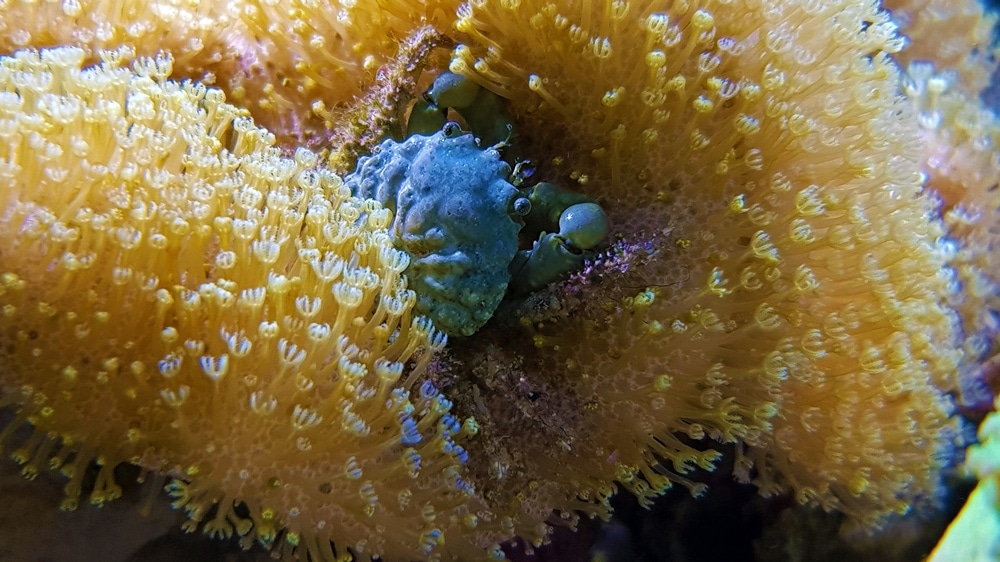
Emerald Crabs are a saltwater crab commonly used in home aquariums because of their consumption of bubble algae. They are one of the most colorful species of crab which is what makes them attractive to humans, but the coloration is also what indicates their toxicity.
As their name indicates, these crabs are generally a deep emerald color, but they may also contain streaks of blue, red, grey, white, or black. Its carapace is often shiny in texture, making its bright coloration stand out even more.
Although they are toxic, they are not generally a threat to humans. Like the crabs in the Xanthid family, they need to be consumed to be toxic. Emerald crabs only reach a diameter of 5 centimeters (2 inch), so they are not a good candidate for a meal.
In the wild, emerald crabs are found in tropical Caribbean reefs in the Gulf of Mexico. They like to hide inside the crevices of caves, rocks, and corals.
8. Floral Egg Crab
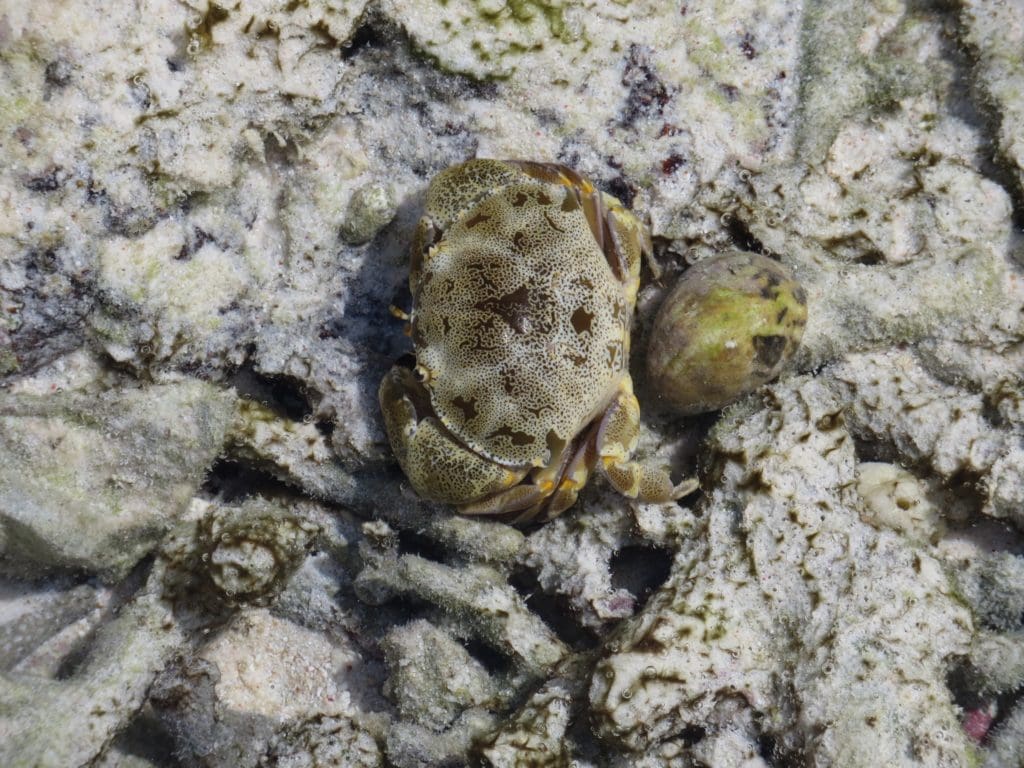
These are another species of toxic crab distinguished by their black-tipped claws. They are found in the Indo Pacific Ocean and have a narrow brown or black, oval-shaped shell. Lace-like white or yellow lines trace across the top of their carapace. They even like to decorate their shell with things they find around them.
Its shell is much wider than it is long, and it has large, oval shaped pincers. They stay fairly small, reaching lengths of about 10 centimeters (4 inch).
Their legs are very thin, and they do not contain swimming legs, so it is apparent that they don’t travel very far. Instead, they use their legs to walk around the same habitat.
Floral egg crabs are more widely distributed, being found throughout Southeast Asia and the Indo-Pacific, all the way down to Australia.
The Largest Crab
Crabs come in all shapes and sizes, with some species certainly being larger than others. When it comes to a body that is larger than all the other crabs, the Japanese spider crab puts the other crabs to shame.
9. Japanese Spider Crab
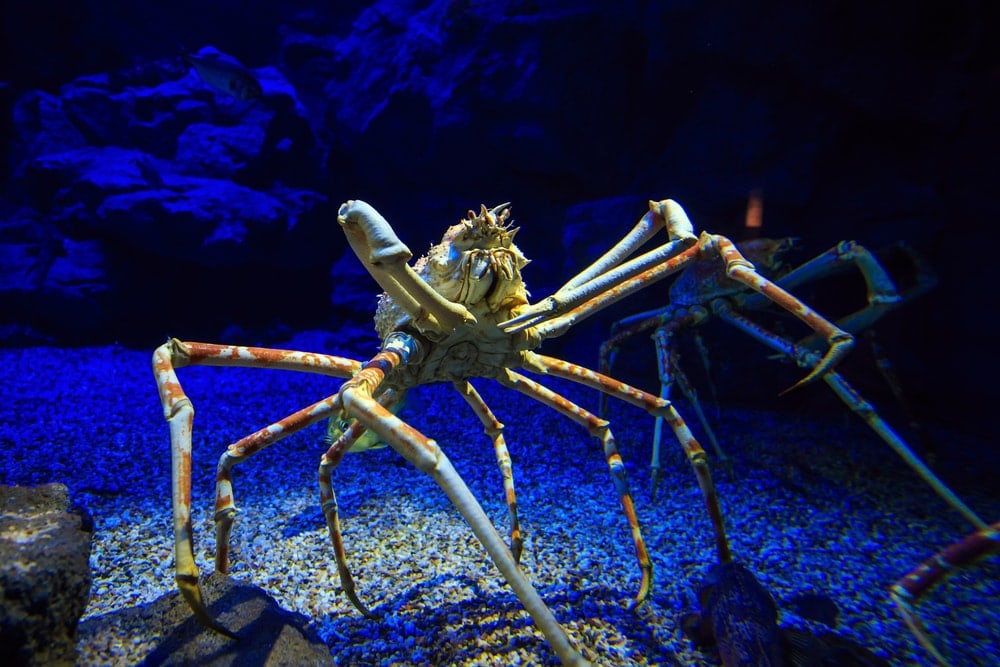
You were probably thinking that the king crab sounded ginormous, but the Japanese spider crab dwarfs the king crab by comparison.
Not only is this species of crab the largest crab in the world, but it is the largest crustacean. It is the largest of all 60,000 species of crustaceans across the globe.
Japanese spider crab’s bodies can reach up to 16 inches (0.4 meters) in length alone. Add their 10 legs which can span 18 feet (0.5 meters) in length, and you have one giant crab! These gentle giants can reach up to 42 pounds (19 kilogram) in weight.
Their coloration is quite unique, their spiny, oval carapaces colored orange and white. This coloration allows them to blend in with the rocks at the sea floor where they live.
Spider crabs love colder waters, inhabiting the pacific coast of Japan at depths as low as 164 to 1,640 feet (50-500 meters). They live best in temperatures of about 50 degrees Fahrenheit (10 degrees Celsius).
The Smallest Crab
We’ve just learned about the largest crab in the world, the Japanese spider crab. On the opposite end of the spectrum, there must also be the smallest crab in the world.
10. Pea Crab

Pea crabs are the smallest species of crab on the planet, their bodies only reaching a length of up to 0.75 inches (0.02 meters).
The name “pea crab” includes any crab in the genus Pinnotheres, a genus of crabs that live in the mantle cavity of some mollusks, polychaetes, or echinoderms. Unlike a parasite, the crab does not take anything from the animal in which it lives, but instead receives protection.
Pinnotheres ostreum, a pea crab also known as an oyster crab, lives in oysters in the coastal Atlantic waters of North America. They are most widely found in the Chesapeake Bay. Females are usually pink in color with a stripe across the center of the carapace. Males are usually even smaller and are brown in color, free swimming through the water column.
Pinnotheres maculatus is another type of pea crab that lives in the mantle cavities of clams, mussels, and scallops. Pinnotheres pisum lives in mussels and cockles shells of coastal European waters.
Land-Dwelling Crabs
Not all crabs live in the water; there are many that live on land permanently or are semi-terrestrial.
11. Blue Land Crab

The blue land crab is also sometimes referred to as the giant land crab and is the largest species of semi-terrestrial crabs in Florida. Although they are called the “giant” land crab, their carapace will only reach about 6 inches (0.15 meters) in diameter.
These crabs change color as they age, beginning life as a dark brown, purple, or orange coloration. As they age, their color will change to a blue-grey color. Like many crabs, one of their pincers is larger than the other.
Blue land crabs prefer warmer waters and can be found throughout the Bermuda region, the Caribbean sea, up to Texas, and southern Florida. Although these crabs live on land, they are semi-terrestrial and are not often found more than five miles off the coast. Instead, they prefer to live in low-lying areas of coastal regions.
Living most of their life on land, blue land crabs need water to drink and to breed. Besides these instances, these land crabs remain on land, creating burrows several feet deep to live in.
Unlike many crabs, these land crabs are mostly vegetarian. Rather than feeding on animal matter like most crabs, they prefer to feast on leaves, berries, flowers, fruit, and vegetables.
12. Coconut Crabs
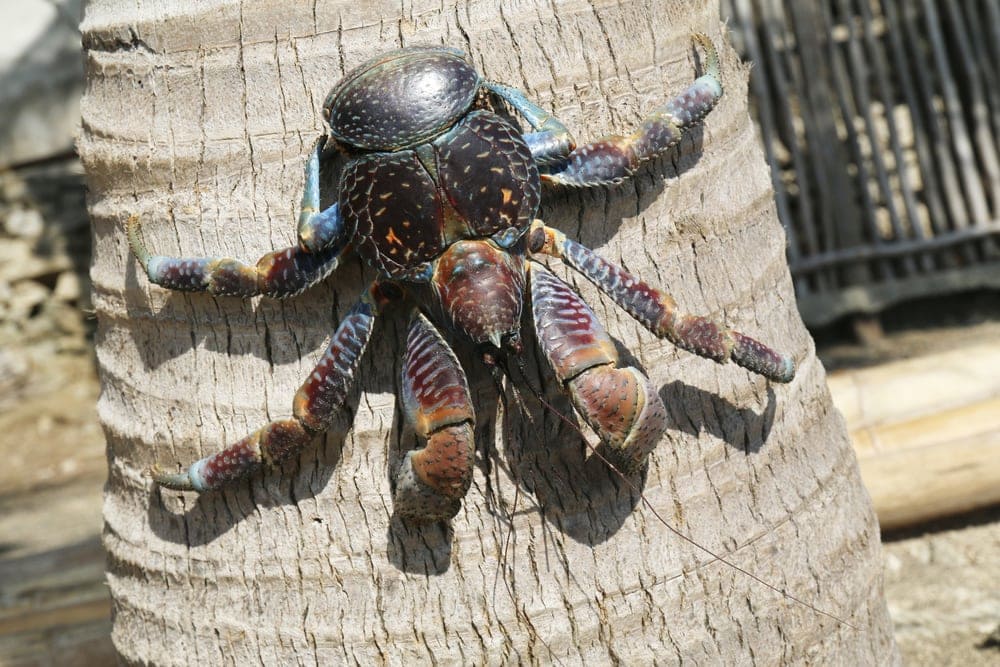
While the Japanese spider crab is the largest crab in the world, the coconut crab is the largest terrestrial species. Not only is it the largest terrestrial crab species, but it is the largest terrestrial arthropod in the world.
Coconut crabs are enormous, their legs spanning up to three feet long. Their pincers are incredibly strong as well, and the crabs can lift objects as heavy as 62 pounds (28 kilograms).
Because of their sheer size, they do not use shells their entire lives. Coconut crabs are a type of hermit crab, so they have to hunt for empty shells to move into, unlike the other crabs on our list that grow with their shells.
Once a coconut crab becomes large enough, they leave their shell and rely on the tough surface of their exoskeleton for protection.
These crabs are found across the Indo-Pacific. They are primarily found on islands off the coasts of Africa to the Gambier Islands of the Eastern Pacific ocean.
As their name suggests, their favorite thing to feast on is coconuts, a delicacy that they hunt for by climbing up trees. However, they will eat other things as well like fruit, nuts, seeds, and even animals. Unlike most crabs who eat mostly dead animals, coconut crabs will hunt rats, birds, and even other crabs.
13. Hermit Crabs
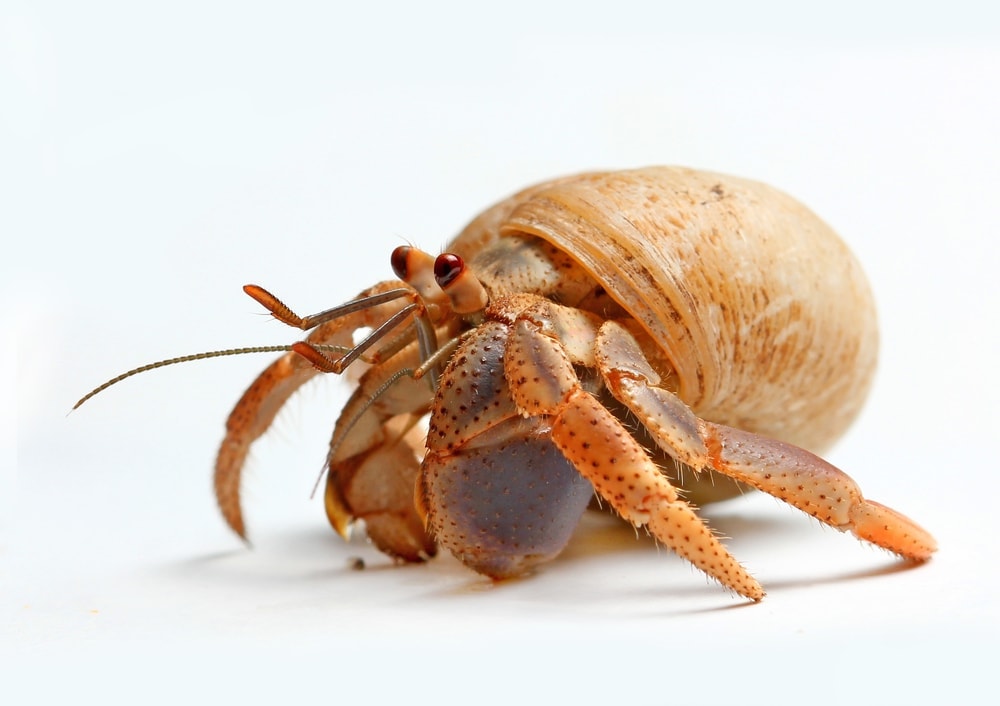
There are over 800 species of hermit crabs across the globe. Most hermit crabs live in the ocean, but there are several species of terrestrial hermit crabs as well, and they are often kept as pets.
Although these are named as crabs, they are not true crabs like the others on this list. Instead, they more closely resemble lobsters. A true crab is an animal that has an exoskeleton that is uniformly hard and can grow their own shell.
Unlike true crabs, hermit crabs only have a hard exoskeleton on the front portion of their body. The tail on the other side of their body is soft, and needs to be protected by a shell that they steal from another animal. Usually, they will seek out already-discarded shells, but if they can’t, they will kill snails and other gastropods for their shells.
Because their shells don’t belong to them, hermit crabs have a tail that is hooked, allowing them to secure themselves in the discarded shell. They routinely need to shed their shell in search of a bigger one as their body grows.
Crabs Kept in Aquariums
14. Fiddler Crabs
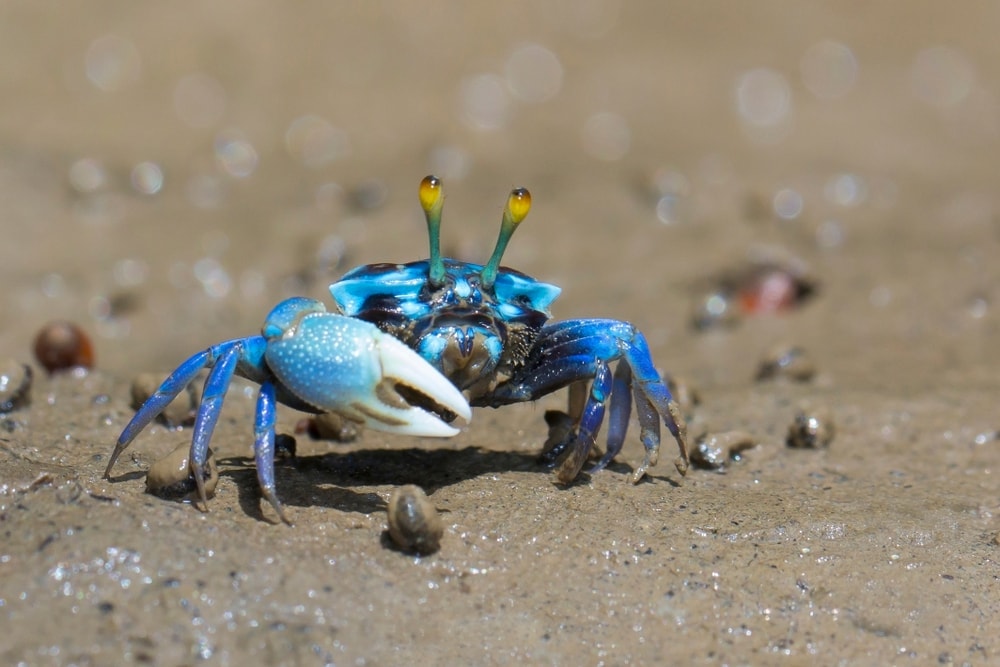
Fiddler crabs are one of the most popular kinds of crabs you can keep in an aquarium as a pet. They only reach 2-3 inches (0.05-0.07 meters) in length, and they are incredibly fun to watch. They have two pincers on their front legs, with one pincer being much larger than the other on males. This pincer is moved around in a dancing motion to attract a mate or intimidate predators.
There are over 100 different kinds of fiddler crabs and some have a very mild coloration, while others are bright and colorful.
If you want to keep a fiddler crab as a pet, there are a few things you need to know. They require brackish water to live in and cannot survive in fully fresh or saltwater. They are also semi-terrestrial, so they need access to land. You will need to provide them with plenty of rocks or decor that allows them to emerge from the water when they want.
Because fiddler crabs live in brackish water and need access to air, many people find it easiest to keep them in a species-only tank. However, if you have a large enough aquarium that allows it, you can keep brackish fish, like mollies, in the submerged portion of the tank.
15. Thai Micro Crab
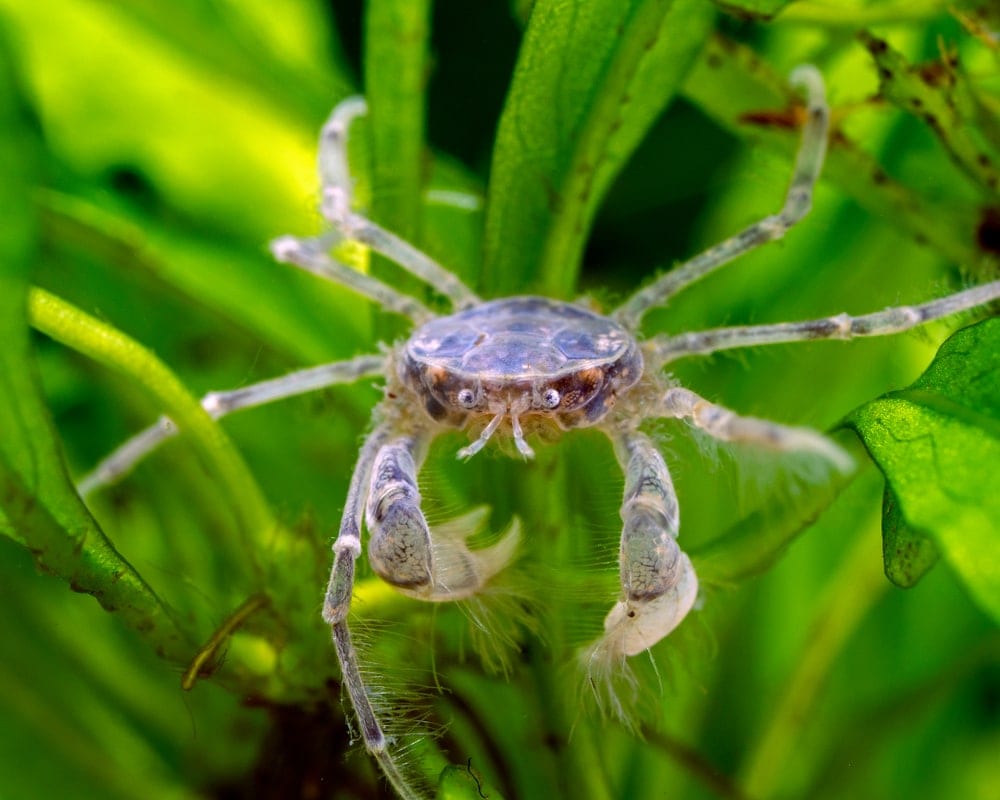
Thai micro crabs are perhaps one of the cutest crabs available for your freshwater aquarium. They are so small that their bodies only grow to be about 0.4 inches (0.01 meters) wide. Their bodies are almost transparent, a light grey-brown color, and they enjoy hiding in vegetation, so they can be difficult to see.
Micro crabs work best in small aquariums under five gallons. Although they may work with some docile fish species, they are best kept with other micro crabs or shrimp who will not pose a threat to them. Unfortunately, their small size makes them easy prey for larger animals.
Unlike fiddler crabs, Thai micro crabs are a purely freshwater species and should not be kept in brackish or saltwater aquariums.
16. Anemone Crabs

Anemone crabs are one of the most popular crab species kept in saltwater aquariums. They are so loved because they are brilliant in coloration. Their edges are a white porcelain color, with the shells having a red polka dot pattern.
The anemone crab does have large claws that they use to hold and eat pieces of meat that they scavenge, but they most often use their fan-like appendages to eat. They wave these appendages about the water column, like a feather duster, to catch microscopic particles of food from the surrounding water.
Their brilliant coloration coupled with their fan-like appendages make them entertaining to watch. They also like to live within anemones, the animals for which they are named. In the home aquarium, they can live without an anemone, although they will be happier if you provide them with one.
Other Common Crab Species
17. Horseshoe Crab
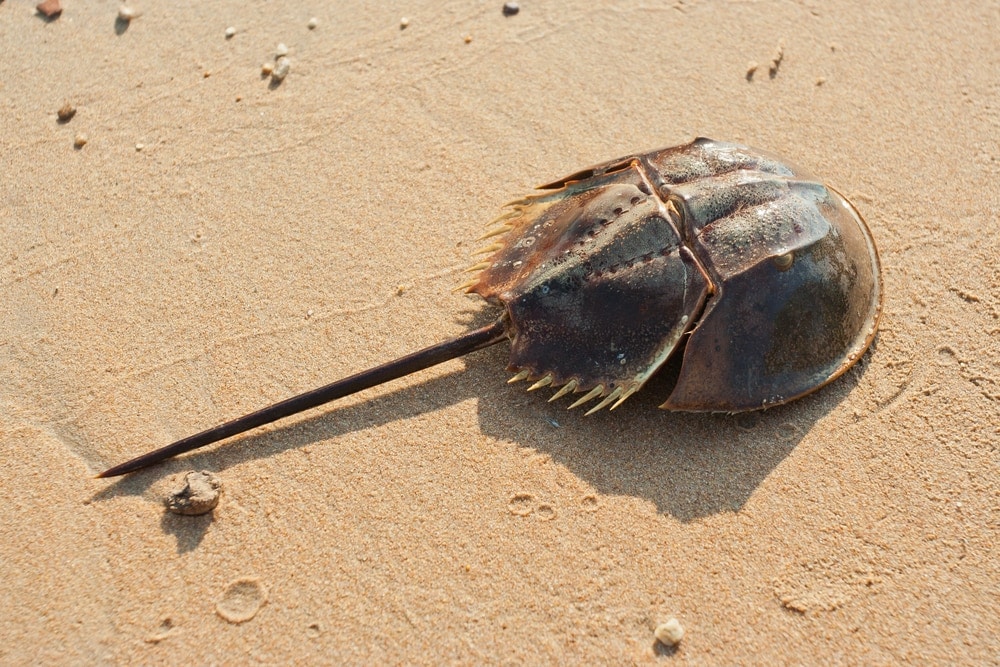
Horseshoe crabs are not actually crabs, despite what their name suggests. They are an arthropod, an invertebrate more closely resembling a crustacean.
These animals can grow to be quite large, and despite this, they are often kept as pets in home aquariums. They can grow up to 24 inches (0.61 meters) long and 12 inches (0.3 meters) wide, weighing in at about 3-4 pounds (1-2 kilogram).
They are commonly found across the Atlantic and Eastern Pacific oceans and prefer to live in shallow water. Horseshoe crabs do not like deep water and live in shallow estuaries and along the continental shelves. They can be found as far north as Maine down to the southern Mexican Yucatan peninsula.
Horseshoe crab blood is incredibly important in medicine because it is used to test for bacterial contamination in drugs. They are often collected for a blood draw before they are released back into the water. Unfortunately, however, 15-30% of the crabs that are released do not survive, so this harvesting process has taken a toll on horseshoe crab populations.
18. Brown Crab
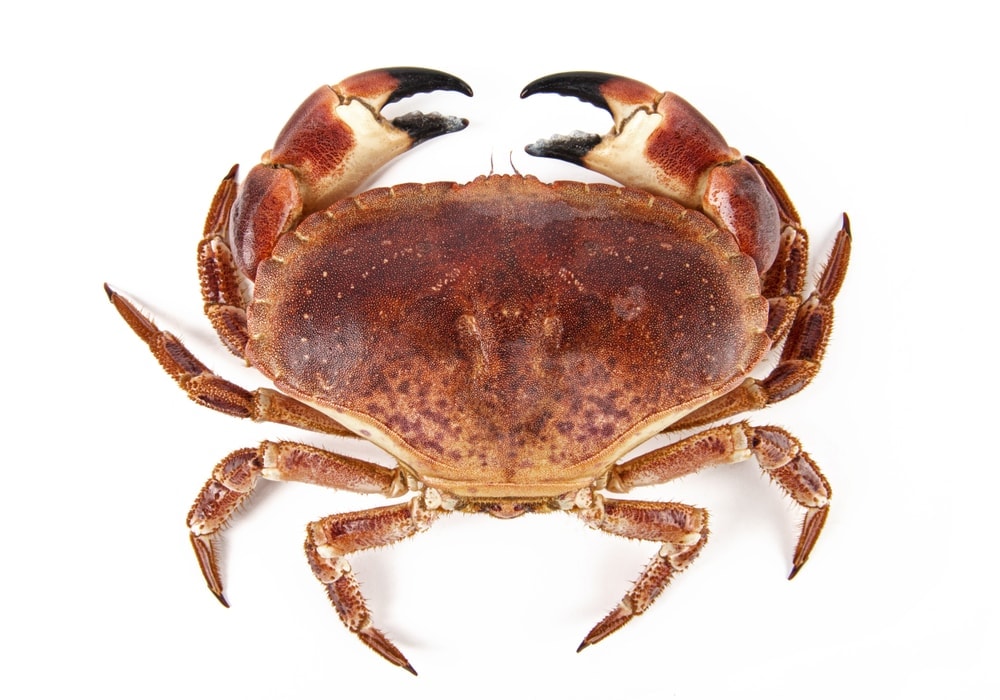
As the name suggests, the brown crab is brown in coloration, often with a reddish hue. When they are cooked to be eaten, their shells turn into a lighter brown coloration. Their claws, on the other hand, are tipped in black.
Brown crab bodies are shaped like an oval, and the edges of their shells are shaped in a wave-like pattern. Sometimes the edges of their shells are referred to as a “pie-crust”.
These crabs are on the larger size of most crabs, the carapace reaching 6-9 inches (0.15-0.22 meters) in length. They can also weigh up to 6.6 pounds (3 kilograms).
These crabs are found in the North Sea, Northern Atlantic Ocean, and the Mediterranean Sea.
19. Horsehair Crab
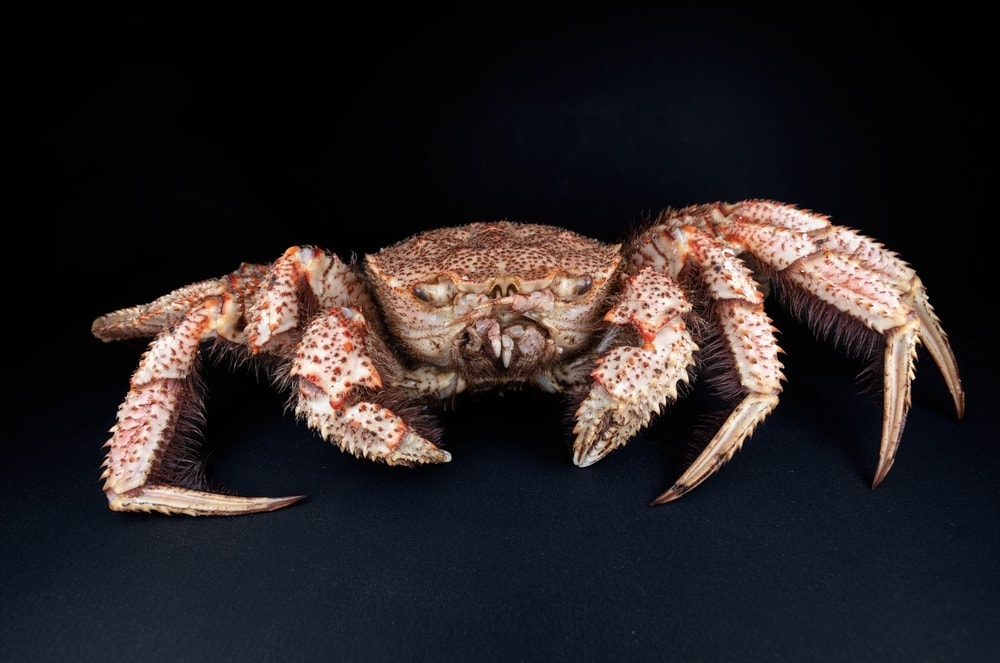
Horsehair crabs are brown and orange crabs with orange dots across them. Their shells have a bumpy texture to them, and they have spiky hairs across their body.
They stay on the smaller side, reaching only about 3.9-4.7 inches (0.09-0.12 meters) in length and only weigh up to 2.2 pounds (0.99 kilograms).
These crabs like to live in colder waters, and they can be found around Alaska and northern Japan. They are bottom-dwelling animals, living at the lowest depths in water as deep as 350 meters (1,148 feet).
20. Peekytoe Crab

The peekytoe crab, otherwise known as the Atlantic rock crab, is a cold-water species. It is named as such because of its brown coloration with purple spots on its shell. “Peekytoe” is a nickname given to the crab because of the pointed shape of its legs.
This crab is moderately sized with a diameter of about 5.25 inches (2.4 meters) long.
Peekytoe crabs used to be considered pests by fishermen, getting caught in the nets of lobster fishermen. They were thrown back as annoying bycatch until about 1997 when they became a common crab sought after by cooks.








